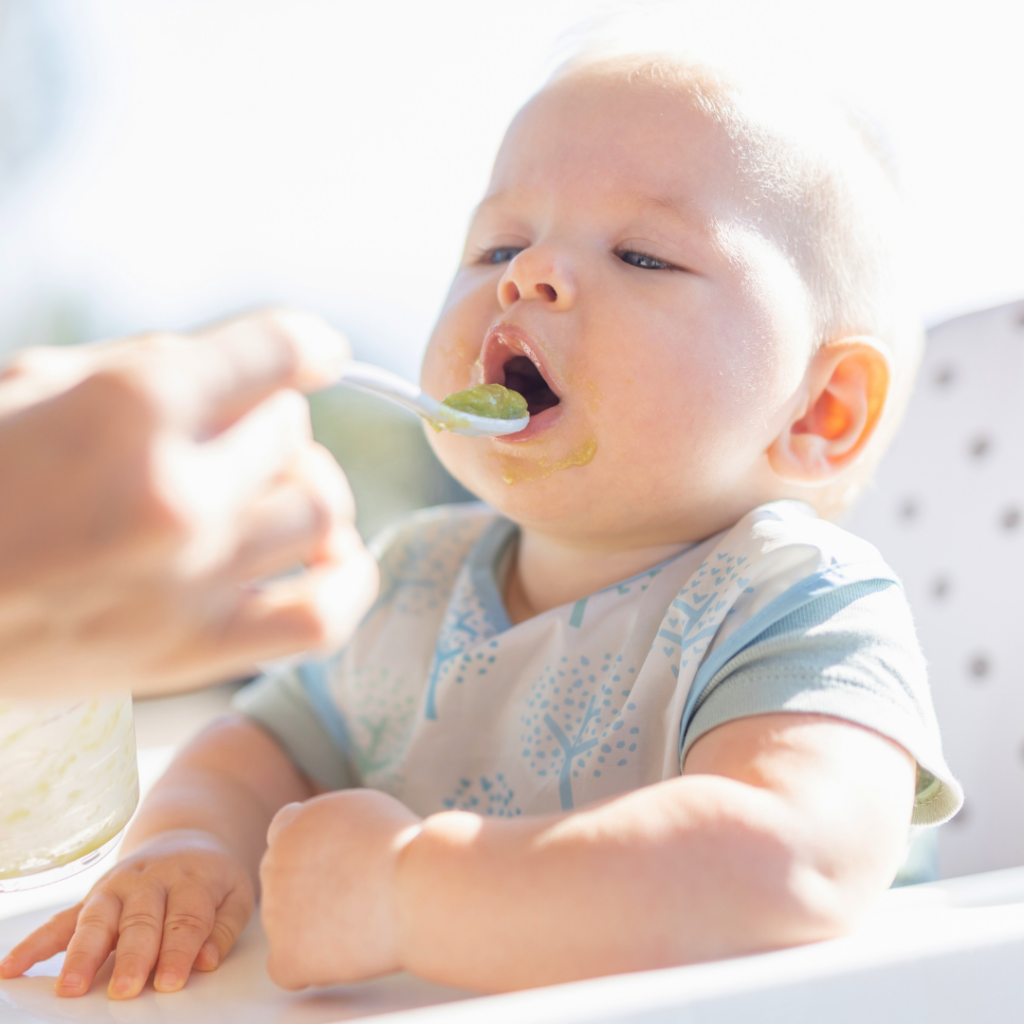This article was written by Megan Cornell of @makingmealtimefun. Megan is a Pediatric Occupational Therapist and picky eating specialist. She is passionate about helping families of picky eaters learn strategies to make mealtime fun. Follow her on Instagram to learn more!
As a pediatric occupational therapist and feeding therapist, parents ask me questions about starting solids all the time, which is great! There is so much to learn and so much you may not even know you don’t know.
But when parents ask for my number one piece of advice when starting solids, I always tell them, “Let your baby get messy!”
Why are messy mealtimes so important? Throughout this blog, we’re going to discuss:
- The benefits of messy mealtimes for your baby.
- How messy meals and sensory play relate to picky eating.
- Plus, 5 sensory activities for your baby that you can do at home!

Table of Contents
If you’re introducing solids to your baby and don’t know how to begin or what to do next, check out the Baby Led Feeding Program.
Complete with video lessons, printable resources, a Texture Timeline™ Food Video Library to search any food and learn how to serve it for the phase your baby is in, lifetime access, and ongoing support – it’s everything you need to feel confident feeding your baby all in one place.
Benefits of messy mealtimes for your baby
Although mealtimes are important for providing your baby with foods and nutrients to help them grow, there are many more benefits than this. Mealtimes also provide your baby with opportunities to explore various textures and sensations, helping them become more comfortable with different sensory experiences.
Babies have unique ways to develop and learn about the world around them. Early learning begins with the whole body through multiple senses.
These senses such as sight, touch, sound, taste, smell, and movement allow babies to receive sensory input, actively explore their environment, gather information about their surroundings, and understand the world around them. Therefore, multisensory experiences are the most natural and familiar way for babies to develop and learn (5).
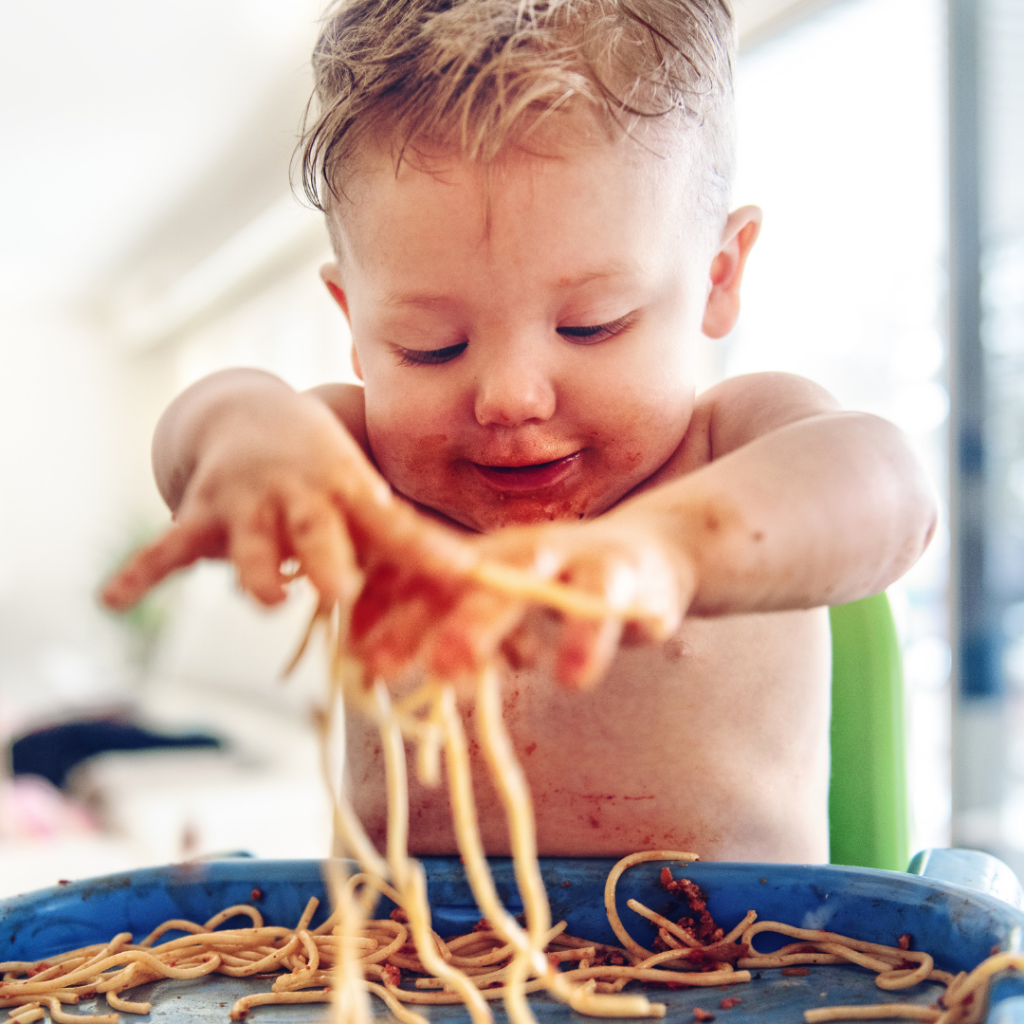
When we allow our babies to be messy during meals with food all over their hands, arms, and faces, we are doing something really important called desensitization.
In the therapy world, desensitization is a fancy term for normalizing the body’s response to certain situations. And like most things in life, the earlier you start, the easier it is!
When we don’t make a big deal about our baby having food all over themselves, what we’re really doing is normalizing that sensory experience. This in turn creates a positive association between being messy and having fun.
Messy mealtimes also provide your child with the opportunity to explore many different textures of foods. Think about the sensory properties of yogurt, peas, toast, celery, shredded cheese, avocados, eggs, and ground beef.
All pretty different, right?

So when babies end up with these foods on their arms and faces during a meal (sometimes there’s more on them than in them!), their bodies become more desensitized to the various textures they’re eating. This tells their brain that each texture of food is “ok”.
a new perspective...
a new perspective...
To fully grasp the benefits of messy play, I think it’s only fair that we try to put ourselves in our child’s position during mealtimes.
If someone put a new food on a spoon that you had never seen before and never even heard of, then immediately expected you to pick up the spoon and eat the food without allowing you to ask any questions or gather any information about the texture, temperature, or taste of the food, how would you feel?
Honestly, this makes me cringe. As adults, we just simply wouldn’t do it, but kids aren’t always afforded that luxury.
So if we can understand the benefits of gathering more information about a food before we as adults eat it, we can understand how much more beneficial it is for babies to do the same.
This means that we need to allow them time to explore the food without pressuring them to eat it right away.
6 sensory steps to eating
Knowing and understanding that babies learn best through sensory-rich experiences is crucial in discussing practical applications of messy play for mealtimes. This is why the six main sensory steps to eating are important.

Here are the steps:
- Looking at a new food
- Interacting with the food using utensils
- Smelling the food
- Touching the food
- Tasting the food
- Eating the food
When we encourage messy mealtimes, we encourage our babies to learn about new foods in a gradual and typical developmental pattern. Allowing your baby to get messy while exploring new foods is crucial in their overall development – and moving through the steps at their own pace is normal.
In addition to providing sensory-rich opportunities, allowing your baby to explore their food also fosters positive associations with food, increased independence, and reduced pressure.

Finally, putting in the effort now will not only allow you to see the benefits in the short term, but you’ll continue to see benefits in the long term as your child grows older.
When we keep these benefits in mind, it can help us to embrace and encourage the mess along the way!
How messy meals and sensory food play relate to picky eating
You’re probably thinking…“Ok, I know that babies learn best through sensory experiences but is the mess really worth the stress?”.
I can’t make that decision for you. But I am here to tell you that the extra mess, stress, chaos, and cleaning during mealtimes now will pay off in the future.

Research studies have found that the enjoyment of tactile play was significantly related to lower food aversions in children (2). Other studies have shown that children have a lower rate of food acceptance if they dislike playing with sticky, messy substances or if they dislike the feeling of non-sticky substances (1).
So what exactly does one thing have to do with another?
Remember when I stated earlier what the six main sensory steps to eating are? Touching a food is step 4 out of 6 – with 6 being the final stage of actually eating the food.
This means that if your child doesn’t like how a food feels, they aren’t going to be interested in eating it. Research has shown that children with tactile defensiveness reject more foods, eat fewer vegetables, and refuse to eat new foods more often (5).
Furthermore, mealtimes are a multi-faceted sensory experience because we have sensory receptors all over our body, including our tongue. Children with tactile sensitivity often find the process of eating to be overwhelming.
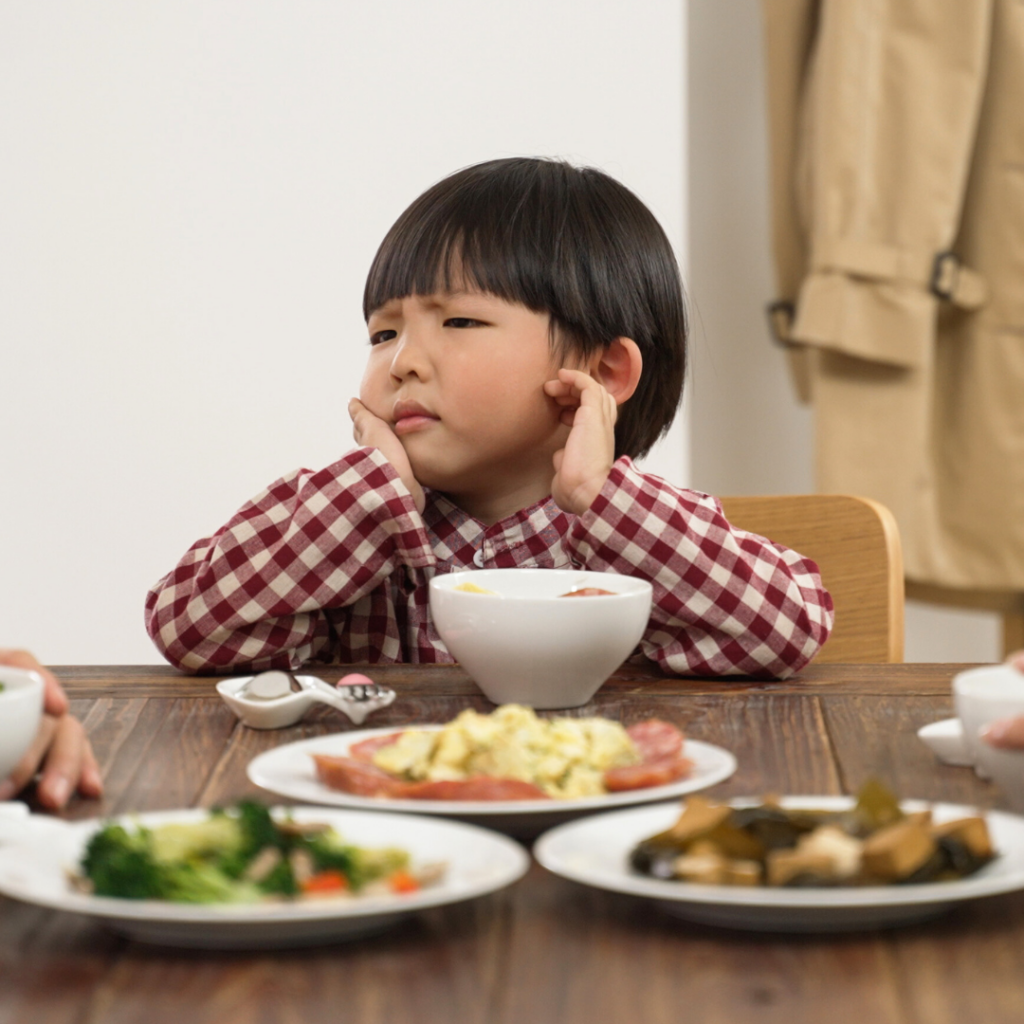
Many children become picky eaters because their bodies are only able to handle and process sensory information from a very select number of foods. And when you introduce a new food to a picky eater, their alarm bells go off because they have not yet had a positive sensory experience with that particular food.
Key Takeaway
Key Takeaway
To give your baby the best chance at becoming a future foodie instead of a picky eater, embrace the messy mealtimes now! The more your baby plays with food from the beginning, the less likely they are to reject foods in the future.
What it comes down to is that the less messy your baby’s mealtimes are now, the more likely it is that you’ll have a picky toddler on your hands very soon. As parents, we often have to pick our battles…a bit of a mess now or a picky toddler later? I’d choose messy play all day!
Edible sensory play ideas for baby
Besides allowing your baby to get messy during mealtimes, you can also incorporate sensory play with food at different times throughout the day. This is beneficial because familiarizing children with the sensory qualities of foods increases their willingness to touch and taste them when they are later offered these foods to eat (4).

The more exposure your child has to new foods, the more familiar and comfortable they become with these foods.
Sensory activities with foods are also beneficial because when your baby is playing with foods away from the table, they are already looking at, interacting with, smelling, and touching those foods. So when you introduce those same foods during mealtime, they are more likely to continue working up the last two sensory steps which are tasting and eating that food.
Not only are sensory activities beneficial for babies, but they can also be beneficial for parents. This is because as adults we associate mealtimes with eating food. This is logical for us because that’s what we do during meals.
However, as stated above, mealtimes serve several purposes for babies including the sensory-rich experience of playing with food. So it can often be more challenging to allow your baby to get messy and play with their food during mealtimes because we feel like they should just be eating.
When your baby or toddler isn’t interested in eating during meals and instead is more interested in exploring and playing with their food, it can be difficult to avoid stressing about their intake which often leads to pressuring them to eat.

Offering sensory activities with food at different times throughout the day can allow your child the opportunity to play with their food away from the table without the pressure of eating anything.
They still get the benefits of sensory-rich experiences with food and you get the benefits of a stress-free activity because you’re not worried about your baby eating, you’re just enjoying them playing. Evidence supports this type of play as a way to increase your child’s food acceptance (3).
If you’re ready to whip out all the fun sensory activities but don’t know where to start, here are 5 of my favorites!
1. Tutti frutti sensory bin
This is the perfect sensory play activity to take outdoors!

Step one: Cut fruits into slices such as oranges, grapefruit, and limes. Be careful to remove any seeds as these would be a choking hazard for your baby and you never know when they might choose to take a taste.
Step two: Place the slices into a container filled with water and put the container on the floor, outside in the grass, or on a table. If putting it on the floor or table, make sure you place a towel underneath it because there will be spills!
Step three: Set your baby down on the floor or grass in front of the container and let them explore! If using a table, put them in their highchair and remove the tray to bring them right up to the table. Your baby will have fun fishing for the fruit while making a splash!
No matter which way you set it up, your baby will need to be able to sit independently to have the core strength needed to reach for the container and explore the fruit. Therefore, this activity would be best enjoyed by babies approximately 6 months and up.
2. Finger painting with purees
Who said you have to use paint when making a masterpiece? Purees make the perfect paint and are taste-safe for your baby to use during sensory play!

Step one: Put some yogurt, fruit puree, or vegetable puree into child-safe bowls or on a medium-sized plate (like an artist’s palette!) to replace traditional finger paints.
Step two: Put your baby in their highchair with a long-sleeved bib on – or you can even do this activity in just a diaper to help with clean up. Give them a sheet of thick paper, a tablecloth, or a paper plate (purees can soak through), and let your little one go to town!
This activity is perfect for babies 6 months+ who are ready for solids (meaning they have all the developmental signs to begin) because chances are they will eat some of the “paint”.
3. Spaghetti noodle dig
One of the most fun activities for any child is hide and seek, so why not play this game with food?
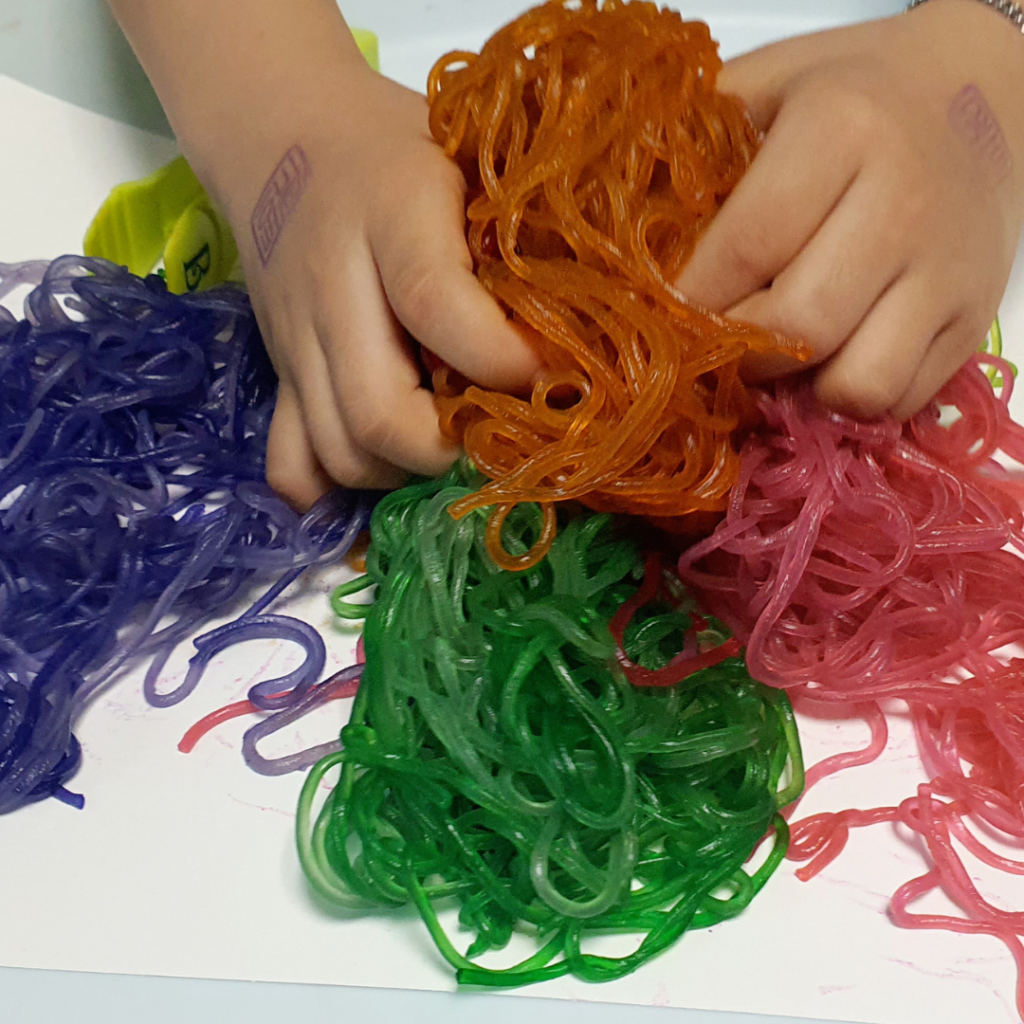
Step one: Cook spaghetti noodles and various diced vegetables (such as carrots, broccoli, squash, etc.).
Step two: Pour all foods into a bowl, layering the veggies and noodles.
Step three: Encourage your child to dig through the spaghetti to see how many vegetables they can find! Let them use their pincer grasp to grab them and put them in another bowl on the side.
This activity is good for babies 9 months+ which is when their pincer grasp typically develops. Just be sure all vegetables used are cooked until soft and cut appropriately.
If you’re unsure about their safety, look them up in our Texture Timeline™ Food Library found within the Baby Led Feeding Program.
It’s also important to note that babies and younger toddlers may not follow the directions for searching for the veggies – and that’s ok! Let them explore this activity in a way that works for them.
4. Fruit and veggie bath
Kids aren’t the only ones that need a bath! For this sensory play, you’ll need small pieces of fruits and vegetables, sugar-free whipped cream, a muffin tin, and a small bowl of water.
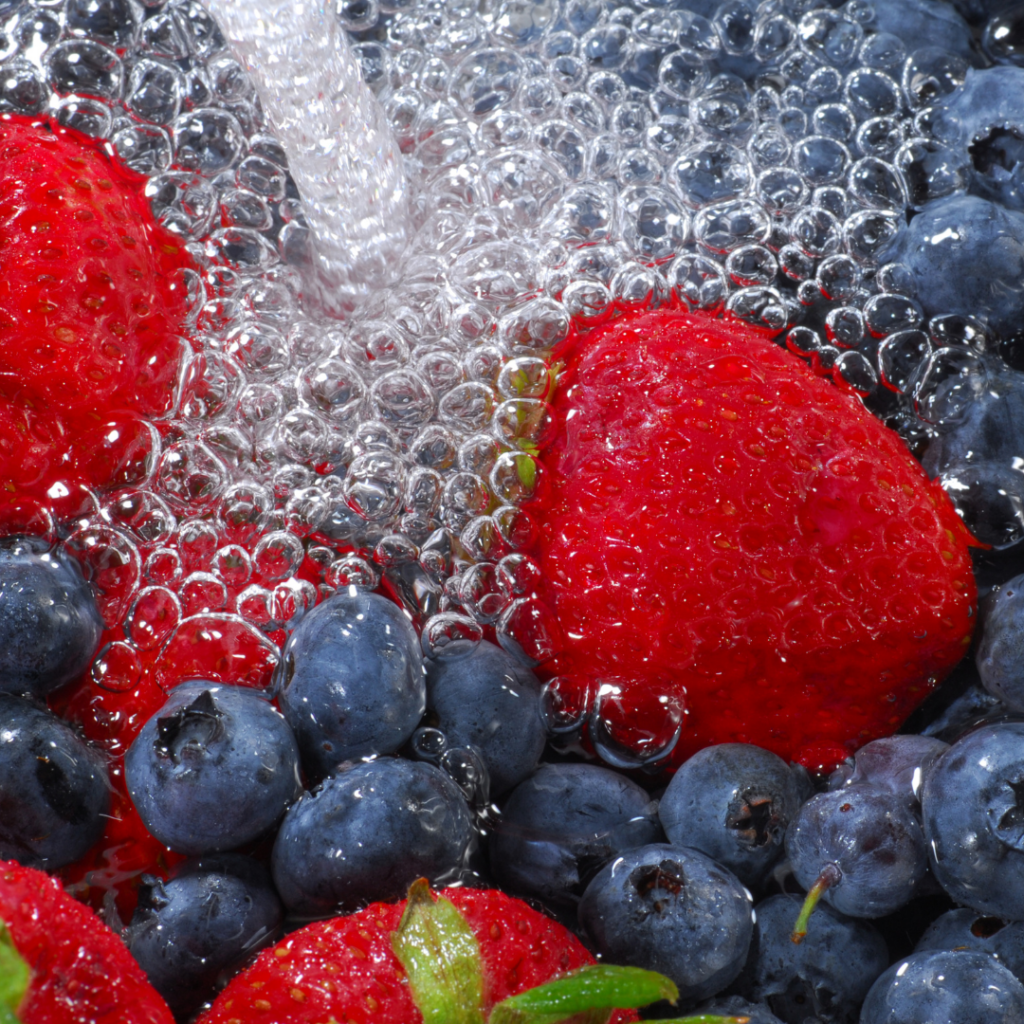
Step one: Put one piece of fruit or veggie inside each hole of a muffin tin. Be sure to prepare any fruits and veggies being used in a safe way for your baby to eat, based on their age and skill level. In case they do decide to eat something, we want to make sure that it won’t be a choking hazard for them or a texture phase that they aren’t ready for.
Step two: Cover each piece of food with the whipped cream.
Step three: Encourage your baby or toddler to search and rescue the pieces of fruits and veggies.
Step four: When they find one, direct them to put it into the bowl of water to give them a bath and wash off all of the whipped cream.
This can be done with babies 6 months+ with the understanding that they likely won’t be able to follow the directions exactly until a bit older. Again, this is ok – the exposure and sensory play with food still counts!
5. Songs and stickers
This is always a big hit for little kids! For this activity, you’ll need some thin slices of cheese or deli meat and mini cookie cutters.
Note: Deli meat actually works a bit better than cheese for this activity, and although My Little Eater doesn’t typically recommend serving it to babies and toddlers, they believe that it would be fine to use in this case (even if they eat some!) – especially if they don’t consume it often.
This activity is best suited for toddlers who are old enough to follow simple directions and use the mini cookie cutters, at approximately 18 months+.

Step one: Use the cookie cutters to make fun shapes out of the cheese or deli meat, pretending they’re stickers!
Step two: Sing the famous song, “If you’re happy and you know it” and model touching the food to different body parts. For example, sing “If you’re happy and you know it, touch your cheek!” Then, pick up a piece of cheese or meat and make it stick to your cheek.
Giggles are guaranteed, making this such a positive experience with food for your little one!
No matter the activity, the most important thing is that your child has fun learning about foods (and getting messy of course!)
If you want more feeding tips, picky eating resources, and strategies to make mealtime fun, follow me on social media @MakingMealtimeFun. I also have picky eating products for sale on Etsy and Teachers Pay Teachers.
Pin these activities to try later!

References
- Coulthard, H., Harris, G., & Fogel, A. (2016). Association between tactile over-responsivity and vegetable consumption early in the introduction of solid foods and its variation with age. Maternal & child nutrition, 12(4), 848–859. https://doi.org/10.1111/mcn.12228
- Coulthard, H., & Thakker, D. (2015). Enjoyment of tactile play is associated with lower food neophobia in preschool children. Journal of the Academy of Nutrition and Dietetics, 115(7), 1134–1140. https://doi.org/10.1016/j.jand.2015.02.020
- Cunliffe, L., Coulthard, H., & Williamson, I. R. (2022). The lived experience of parenting a child with sensory sensitivity and picky eating. Maternal & child nutrition, 18(3), e13330. https://doi.org/10.1111/mcn.13330
- Dazeley, P., & Houston-Price, C. (2015). Exposure to foods’ non-taste sensory properties. A nursery intervention to increase children’s willingness to try fruit and vegetables. Appetite, 84, 1–6. https://doi.org/10.1016/j.appet.2014.08.040
- Nederkoorn, C., Jansen, A., & Havermans, R. C. (2015). Feel your food. The influence of tactile sensitivity on picky eating in children. Appetite, 84, 7–10. https://doi.org/10.1016/j.appet.2014.09.014
- Shin, M. (2021). Exploring multisensory experiences in infants’ learning and development in the child care classrooms. Early Child Development and Care, 191(13), 2116–2127. https://doi.org/10.1080/03004430.2019.1695127

Megan Cornell, OT
Megan Cornell is a pediatric occupational therapist and feeding specialist. She received her Bachelor’s Degree in Psychology and her Doctorate degree in Occupational Therapy from the University of Central Arkansas. Megan is trained and mentored in the Sequential Oral Sensory (SOS) Approach to Feeding. Megan released her first product, the Fun with Food card deck in September 2023. This resource contains 99 games and activities to help picky eaters learn about new foods using a play-based and evidence-based approach.

Megan Cornell, OT
Megan Cornell is a pediatric occupational therapist and feeding specialist. She received her Bachelor’s Degree in Psychology and her Doctorate degree in Occupational Therapy from the University of Central Arkansas. Megan is trained and mentored in the Sequential Oral Sensory (SOS) Approach to Feeding. Megan released her first product, the Fun with Food card deck in September 2023. This resource contains 99 games and activities to help picky eaters learn about new foods using a play-based and evidence-based approach.

